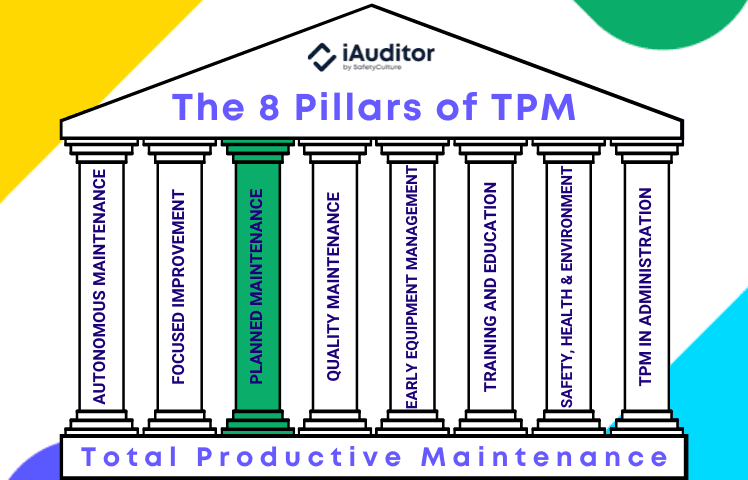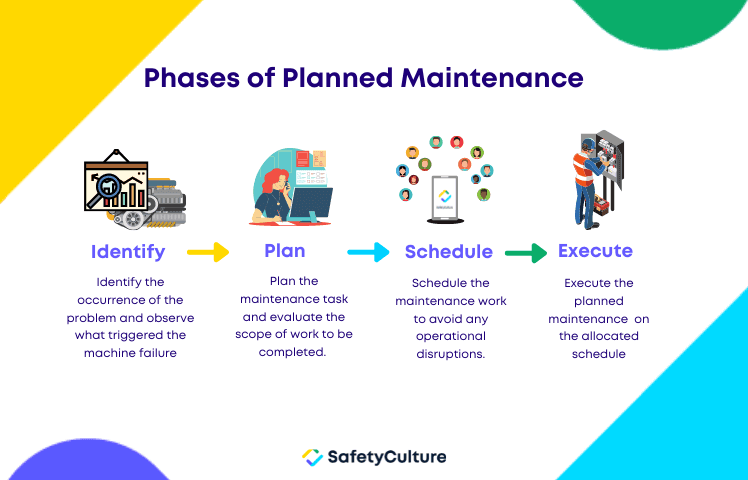What is Planned Maintenance?
Planned maintenance is a scheduled approach to upkeep equipment or service products to ensure businesses can operate without interruption. It is one of the eight pillars of Total Productive Maintenance (TPM) that uses observation of historical downtime and failure rates to achieve zero deficiencies or machine breakdowns.

Planned Maintenance: 8 Pillars of TPM | SafetyCulture
What is the Difference Between Planned and Preventive Maintenance?
Maintenance is a necessary investment for any organization. It involves functional checks to eliminate equipment defects, machine breakdowns, operational delays, and consequently, accidents. It is classified into two strategies: proactive maintenance strategy and responsive maintenance strategy.
Planned and preventive maintenance are types of maintenance that fall under a proactive maintenance strategy in which the inspection should be carried out before any significant breakdowns or failures occur. Planned maintenance follows significant schedules based on observation and research while preventive maintenance can be performed daily.
An example of how planned maintenance works with preventive maintenance tasks in the manufacturing industry is when equipment, which we will call Machine A, naturally gets its oil level go below normal every month. Planned maintenance can be performed monthly to replenish the oil in Machine A to avoid machine failure. As for preventive maintenance, Machine A should be checked regularly to ensure that the oil is at an appropriate level at all times. This can also be applied to other industries reliant on mechanical equipment, such as agriculture.
What are the Advantages of Planned Maintenance?
The good thing about planned maintenance is that it can be performed during non-production days or downtimes to not interfere with the overall production. By implementing it, organizations can reap the following benefits:
- prevent unexpected equipment failure;
- minimize maintenance cost;
- improve the overall equipment performance for effective asset care;
- set standards in the pursuit of autonomous maintenance goals;
- plan and allocate resources appropriately; and
- improve workplace safety.
What are the Four Phases of Planned Maintenance?
Planned maintenance is a reliable strategy for companies that are aiming to minimize maintenance costs, boost their profitability, and enhance workplace safety. The following phases will guide you through its implementation in the organization.

Phases of Planned Maintenance | SafetyCulture
Phase 1 – Identify
Identify the occurrence of the problem and observe what triggered the machine failure. Collect the needed information and diagnose the equipment to understand its current condition. Furthermore, if previous records are available, compare them with the current issue to hasten the analysis process.
Phase 2 – Plan
Plan the maintenance task and evaluate the scope of work to be completed. It is crucial to determine the workload, priority level, required skills, and sequence of activities to maximize the value of preventive maintenance. Check if third-party contractors and other outside resources were needed for maintenance tasks including work permits, tools, manpower, and other equipment. Ensure all resources are available before scheduling the maintenance work.
Phase 3 – Schedule
Scheduling the maintenance work is vital to avoid any operational disruptions. It is important to inform all users who would be affected by the maintenance work to prepare to prevent lost data or unsaved work that may affect their productivity. Check the availability of all needed resources and ensure they are ready to use on the set maintenance schedule.
Phase 4 – Execute
Time is significant when performing scheduled maintenance. As much as possible follow the allocated schedule for the maintenance work, but if something unexpected, such as a bug, happens, the maintenance team should update all the affected groups to set their expectations.
The maintenance team should meet the required quality standards and ensure equipment, tools, or machinery are operational after the maintenance work. They have to monitor, observe and document the maintenance work including safety precautions, shutdown procedures, and other important information.
Achieve operational excellence
Cultivate a culture of excellence with our digital solutions that enhance efficiency, agility, and continuous improvement across all operations.
Explore nowHow does Planned Maintenance Improve System Reliability?
Planned maintenance aims to reduce workflow interruption and machine failure with minimal cost. It helps increase system reliability and extend the asset life span by identifying and dealing with both technical and consequence-related aspects of specific failure modes. With proper documentation of acceptable tolerances of different machines and other tools, planned maintenance can help provide appropriate solutions and needed updates to avoid system issues or failure.
Using Mobile Applications for Planned Maintenance Inspections
Traditionally paper-based maintenance checklists are used when performing inspections. This method uses pen and paper to gather and document data that is prone to deterioration, damage, or loss. Somehow, it is burdensome for facility managers to keep a record of maintenance history and attach photo evidence of maintenance work.
SafetyCulture (formerly iAuditor) is an inspection software app that can transform your existing paper-based maintenance checklist into a digital form. Eliminate clunky paperwork and enhance maintenance practices using a digital checklist. With SafetyCulture you can:
- set the schedule of maintenance work and be notified before the set date;
- perform inspections and capture photo evidence in-app;
- train workers for maintenance training and tasks;
- store maintenance data in a cloud; and
- assign corrective actions to appropriate members of the organization to solve issues right on time.
After performing maintenance works, facility managers can easily inspect if the processes and procedures are executed properly with a digital checklist. They can also send maintenance reports in real-time with a single tap of a finger.




